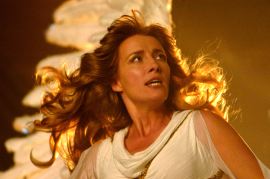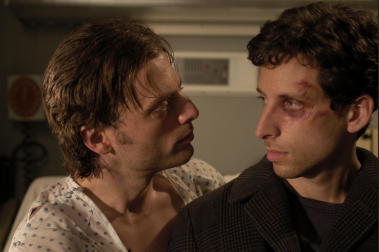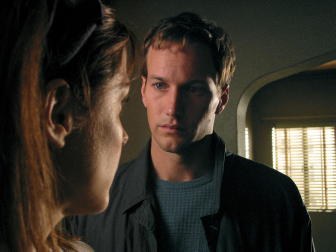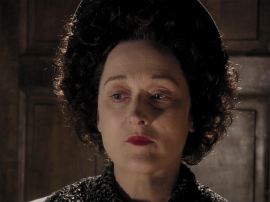|
Since I’ve not seen Tony Kushner’s Pulitzer Prize winning play, ”Angels in America,” you can imagine how surprised I am to find, after having lived in Sacramento for fifteen years, that Heaven is only ninety miles away. Yes! Another name it’s known by is San Francisco. That’s where the new HBO film, “Angels in America” begins: above the clouds, just over the Golden Gate Bridge. The camera, as if attached to some silent rocket ship, streaks inland over Salt Lake City, St. Louis and Chicago to New York City’s Central Park---stopping then just in front of the statue of The Angel of Bethesda. After a moment, the statue looks up. With accompanying music composed by Thomas Newman (“American Beauty” and “Six Feet Under”), it is a visually moving way to begin Kushner’s iconoclastic and operatic take on some recent and excruciating American history.
Justin Kirk and Ben Shenkman
Mary Louise Parker and Patrick Wilson
As you’ve probably heard, Meryl Streep is in the cast. But I’ve left mention of her role or, I should say, roles for this later paragraph because, as important and incredibly well done as they are, all of them are peripheral. Streep plays an old rabbi, the Mormon husband’s mother, and the Ghost of Ethel Rosenberg. (You may wish to read the preceding sentence again.) No one has ever stretched themselves acting as Meryl Streep does for “Angels in America.”
Meryl Streep
With these scenes, in particular, Kushner is doing precisely what theatre (and, hopefully, film) is supposed to do. It is compelling art---which just happened, thanks to HBO, to have been disseminated by cable television. It will play powerfully long after those of us who are fortunate enough to see this film are gone. But what of the angel and Emma Thompson, who plays her? With this character, “Angels in America” takes away a little of the vastness of the wasteland that defines so much of television. The angel is gentle, lovely, proud, pushy and bi-sexual. In one of her several hallucinated appearances, she makes a prophet of the young man with AIDS. As you might imagine, the angel is quite amazing. And the special cinematic effects to make her so are part of why television is so much the better after having given wing to “Angels in America.” (As the angel, Emma’s got some great eyebrows.) I don’t believe any of us will ever forget her with her wings and beautiful mezzo voice that speaks in an American accent. Al Pacino as Roy Cohn comes last, but is the best in this superb, "as-good-as-it-gets" cast. Of all the good and great performances Pacino has given through the years, this one’s it. It’s as if everything he’s done till now has been preparation for portraying a real-life person who might be called The High Priest of Villains. Scarface, Godfather, get out of the way of Roy Cohn.
Mike Nichols has directed this film. He’s one of a very few in the movie business that I always think of when sorting out the directors who do the best of the intimate, important motion pictures. Looks like Nichols is still up to his old tricks. The young man whose relationship suffers after he’s diagnosed with AIDS is the character who is made into a prophet by the angel. In one of his hallucinatory dreams, he goes to Heaven. It’s a scene you must see cold. However, way back in the distance in the Heaven scene, there, spanning San Francisco Bay, sits the Golden Gate Bridge. It is so totally outrageous and yet so poetic; something that’s bound to start a vigorous conversation, and not just in the Bay Area. It’s probably best that “Angels in America” has been made for cable television, for if this big Hollywood production had been distributed to cinemas around the country, it would be winning more Oscars than tickets sold. I would like to see Emma Thompson’s eyebrows on a big, wide screen someday, though.
|






